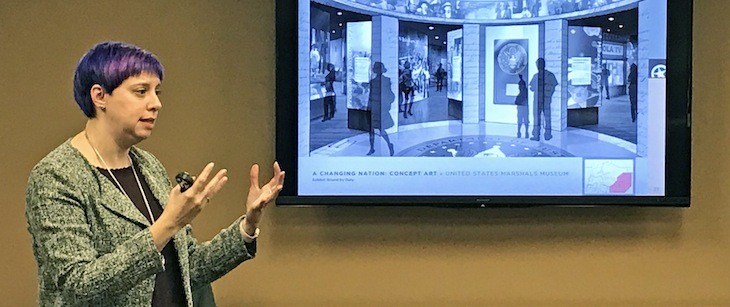U.S. Marshals Museum building to be named after donors, $19.7 million left to raise
by January 16, 2018 4:44 pm 1,622 views

Cynthia Sharpe with Thinkwell explains some of the concepts behind planned exhibits for the U.S. Marshals Museum.
The United States Marshals Museum (USMM) Board of Directors voted Tuesday (Jan. 16) to name the future museum building space after Mary Carleton and Robert A. Young III for their support and contributions to the nearly decade-long campaign that is set to culminate with a Sept. 24, 2019 opening, the 230th anniversary of the U.S. Marshals formation.
The museum will be built in downtown Fort Smith near the Arkansas River.
“Mary Carleton and I are humbled to lend our name to the U.S. Marshals Museum and its mission,” said Young, chairman of the USMM Foundation. “The museum has been, and will continue to be, a catalyst for positive change. We look forward to seeing the impact it makes not only in our children and grandchildren’s lives, but for other families’ across the state and nation.”
“Since its inception, Mary Carleton and Robert have been instrumental to the museum’s progress,” said Jim Dunn, president of the USMM Foundation. “They have given their support, enthusiasm, and resources to make this project a reality. I can think of no individuals more deserving of this honor.”
The museum revealed it still needs to raise $19.7 million to reach its final $58.6 million goal, and Dunn acknowledged there may be “a gap” between that number and what the museum is able to raise before it opens, but under questioning from a Board member at Tuesday’s meeting, he said the “time is right.”
“The time is now, and I think the naming of the building in honor of Mary and Robert is a key factor in helping us raise the additional $19.7 million that we need, and I will tell you that there is no one who comes close at present to doing what Robert and Mary have done, and there is not a realistic opportunity for someone to come along and drop $10 million on us,” Dunn said, adding that the museum “doesn’t have a $10 million prospect.”
Dunn continued: “We closely considered this issue, and let me tell you that we presented this idea to Robert and Mary, and Robert’s first reaction was, ‘Look, if you get someone else that will contribute $10 million to this museum, do it, because we didn’t come into this with the expectation of having anything named for us.’ And I just think when you consider where we are, who they are, and what our prospects are, the time is right.”
The Youngs have played a key leadership role in raising money for the museum’s capital campaign through the foundation, which has been responsible for initiatives such as the Winthrop Paul Rockefeller Distinguished Lecture Series. They also co-chaired the Kickin’ Up Dust Gala with Kathy and Doug Babb, and Young has served as chairman of the USMM Foundation Board since 2009.
Construction on the 50,000-square-foot facility will begin in spring of 2018. Once completed, it will include iconic features inspired by the U.S. Marshals Service badge. It will be a state-of-the-art national museum focused on providing visitors with what it calls “a transformative storytelling experience.”
On Tuesday, Thinkwell: The Experience Co., a Los Angeles-based design firm with offices in Abu Dhabi and Beijing, presented a taste of that with schematic concepts for a five-part museum experience utilizing, in part, interactive storytelling, animations, and projection.
The designs included five sections. “To Be a Marshal” will be an overview of what U.S. Marshals do and who they are. “Campfire Stories Under the Stars” will feature an intimate look at Marshals lives as told around a “campfire” with Marshals statues dressed in different garb throughout the service’s history. “Frontier Marshals” will be an experience focusing on the Marshals’ work originating in Pennsylvania and expanding west. “A Changing Nation” will show visitors how the Marshals service has functioned alongside major national shifts like sovereignty and Civil Rights. Finally, “Modern Marshals” will focus on the Marshals service from the 1980s to the present.
The Museum will feature a “Hall of Honor” as well, to honor U.S. Marshals killed in the line of duty.
In late 2017, the museum rolled out a virtual tour experience allowing visitors to see how the museum will appear — interiors and exteriors — on the existing building pad through the use of virtual reality goggles.
